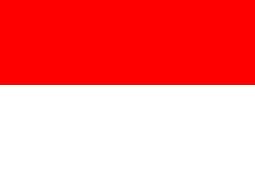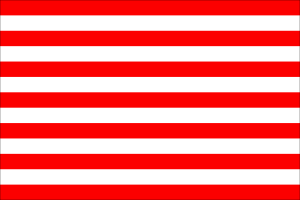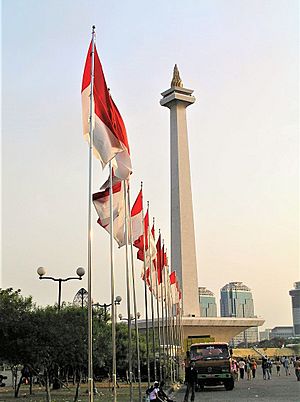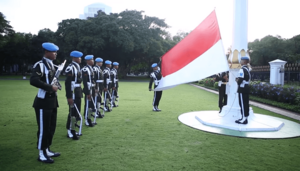Flag of Indonesia facts for kids
 |
|
| Name | Sang Saka Merah-Putih Bendera Merah-Putih Merah-Putih |
|---|---|
| Use | National flag and ensign |
| Proportion | 2:3 |
| Adopted | 13th century (Majapahit Empire)(disputed) 28 October 1928 (standardized) 17 August 1945 (original) 17 August 1950 (official) |
| Design | A horizontal bicolour of red and white |
The Flag of Indonesia is a simple flag with two horizontal stripes. The top stripe is red, and the bottom stripe is white. The flag's shape is a rectangle, with its width being two-thirds of its length (a 2:3 ratio). This flag was first shown to the public when Indonesia declared its independence on August 17, 1945. It was raised again when the Netherlands officially gave Indonesia its freedom on December 27, 1949. The flag's design has stayed the same ever since.
The Indonesian flag looks very similar to the flag of Monaco. The main differences are a slightly different shade of red and a different size ratio. The flag of Poland also has similar sizes but its colors are swapped: white on top and red on the bottom.
The "Naval Jack of Indonesia" is a special flag used only by the Indonesian Navy. It flies on warships when they are docked or on special occasions. This naval flag has nine stripes: five red and four white, alternating. It is sometimes called Sang Saka Merah Putih, which means "The Heirloom Red-White". This naval flag's design comes from the ancient Majapahit Empire. This empire was known for its strong navy, and its ships used similar flags.
Contents
History of the Indonesian Flag

The red and white colors of Indonesia's flag come from the banners used by the Majapahit Empire in the 13th century. Some people believe these colors have an even older meaning. They might come from ancient Austronesian stories about Mother Earth (red) and Father Sky (white). This idea of red and white representing two important parts of nature is why these colors appear in many flags across Austronesia, from Tahiti to Madagascar.
The first written records of red and white flags in Indonesia are from the Pararaton chronicle. This book says that in the early 12th century, troops from Gelang-Gelang used red and white banners when they invaded Singhasari. This shows that red and white were important colors for kingdoms even before the Majapahit era, like in the Kediri kingdom (1042 – c. 1222).
People in ancient Indonesia knew how to make red and white fabrics. White was the natural color of cotton. Red dyes came from plants like teak leaves, Averrhoa bilimbi flowers, or the skin of mangosteen fruits.
Many other kingdoms in Indonesia also used red and white. For example, King Sisingamangaraja IX of the Batak lands had a battle flag with white swords on a red background. During the Aceh War (1873–1904), Aceh warriors used a red flag with white symbols like a sword, star, and crescent. The Buginese Bone kingdom in South Sulawesi had a red and white flag called Woromporang. Even Prince Diponegoro used a red and white banner during the Java War (1825–1830).
In the early 1900s, students and nationalists started using these red and white colors again. It was a way to show their desire for independence from the Dutch rulers. The modern red and white flag was first flown in Java in 1928. The Dutch government then banned it. But when Indonesia declared independence on August 17, 1945, this flag became the national flag and has been used ever since. After Indonesia's independence was recognized, Monaco, which had a similar flag, complained, but their complaint was mostly ignored.
The Hotel Yamato Incident

A famous event involving the flag happened during the Indonesian War of Independence. In late 1945, before the Battle of Surabaya, Indonesian youths climbed the Yamato Hotel. They took down the Dutch flag, tore off its blue stripe, and then raised it again as the Indonesian flag. The hotel was later briefly renamed Hotel Merdeka, which means "independence hotel."
-
Flag of the Dutch East India Company (1602–1800)
-
Flag of the Dutch East Indies (1800–1949)
-
Flag of Imperial Japan (1942–1945)
Names of the Flag
The official name for the flag is Sang Saka Merah-Putih. This means "lofty bicolour Red and White." This name comes from Article 35 of the 1945 Constitution. People commonly call the flag Bendera Merah-Putih, which means "Red-and-White Flag." Sometimes, it is also called Sang Dwiwarna, meaning "The Bicolour."
Sang Saka Merah-Putih also refers to a special historical flag called Bendera Pusaka (heirloom flag). This was the flag flown in front of Sukarno's house when he declared Indonesia's independence on August 17, 1945. The original Bendera Pusaka was sewn by Fatmawati, Sukarno's wife. It was raised every year at the Merdeka Palace during the Independence Day ceremony. It was last raised on August 17, 1968. Since then, the original flag has been kept safe because it is too old and fragile. A replica is used for ceremonies now.
What the Colors Mean
People have different ideas about what the red and white colors in the Indonesian flag mean. One common idea is that red stands for courage, and white stands for purity. Another idea is that red represents the human body or physical life, while white represents the soul or spiritual life. Together, they represent a complete human being.
As Sukarno, Indonesia's first president, said:
Red is the symbol of courage, White is the symbol of purity. Our flag has been there for 600 years.
The colors are the same as those used in the flag of the Majapahit Empire.
How to Use the Flag

Rules for the Flag
The rules for using the flag are written in Indonesia's Constitution and other government rules. The flag should usually be raised between sunrise and sunset. But sometimes, it can be flown at night.
The flag should be flown every day on special occasions, like Indonesian Independence Day on August 17. Citizens can fly it at their homes, offices, schools, and on public transport. Indonesian offices in other countries also fly it.
The flag can also be used to cover the coffin of a President or Vice President, government officials, or members of the Indonesian Armed Forces and Indonesian National Police who died while serving their country. It is also used for Indonesian citizens who made important contributions to the nation.
The flag must be displayed every day at places like the Presidential Palace, government buildings, border posts, and national heroes' cemeteries.
The flag should be displayed everywhere on these special days:
- May 2: National Education Day.
- May 20: National Awakening Day.
- June 1: Day of the Birth of Pancasila (Indonesia's founding principles).
- August 17: Indonesia Independence Day.
- October 28: Youth Pledge Day.
- November 10: Heroes Day.
Half-Mast Flag
The flag should be flown at half-mast (halfway up the flagpole) as a sign of mourning on these days:
- December 26, to remember the victims of the 2004 Indian Ocean earthquake and tsunami.
- For three days after the death of a President or Vice President, government officials, or the Speaker of the People's Representative Council.
- Other mourning days decided by the government.
The flag was also traditionally flown at half-mast on September 30 to remember the 30 September Movement. This tradition stopped for a while after 1998 but has recently started again.
Things You Should Not Do with the Flag
Based on Indonesian law, citizens are not allowed to:
- Destroy, tear, step on, burn, or do anything else to make the flag look bad or disrespect it.
- Use the flag for advertisements or commercials.
- Fly the flag if it is torn, dirty, wrinkled, or faded.
- Print on it, embroider it, or add any letters, numbers, pictures, or other signs to the flag.
- Use the flag to cover a ceiling or roof, or to wrap goods in a way that disrespects the flag.
See also
 In Spanish: Bandera de Indonesia para niños
In Spanish: Bandera de Indonesia para niños
- Flag of Indonesia size guidelines








